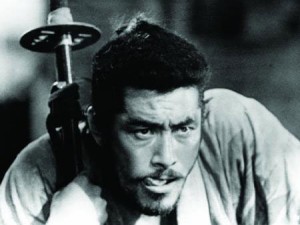Seven Samurai ***** (1954, Toshiro Mifune, Seiji Miyaguchi) – Classic Movie Review 224
Director Akira Kurosawa’s beloved, world-famous 1954 Japanese epic is the quintessential samurai masterpiece and, arguably, the first modern action movie. Made during the country’s golden age of cinema after WW2, it also has a strong claim to be the greatest Japanese film ever made.
Dynamically driven, it is a perfectly judged mixture of thrills, comedy, action and emotion, motoring on a great, meticulously written story and a whole ensemble of quirky, factually-based characters and superlative performances from the ideal, hand-picked cast.
The now-classic plot that also provides the basis for the even more famous 1960 Western remake, The Magnificent Seven, pounds it along magnificently. In return for gaining honour (though that might mean an honourable death of course) and a meagre pittance of bowls of rice (at least they won’t die starving), the magnificent seven warriors of the title agree to band together to help protect the hundred or so good folks of a 16th-century Japanese village from an annual attack by a large number of marauding bandits.
The year is 1574. Firstly the poor, pathetic farmers desperately persuade veteran samurai Takashi Shimura, who’s fallen on hard times, to help them defend themselves. And secondly he then signs up a motley crew of six other unemployed samurai (including most notably the iconic Toshiro Mifune as Kikuchiyo and Seiji Miyaguchi as the stoic, taciturn master swordsman Kyuzo) to take on the might of the bad guys who come with regular monotony year in, year out to intimidate the villagers and steal their harvest. Their pay is to be just three small meals a day, all the villagers can afford.
It says volumes for Kurosawa’s skills as a film-maker that the, on the face of it, far-less-exciting extended opening recruit scenes that introduce the characters and establish the samurai’s personalities, and then the scenes of the villagers in training to defend themselves that follow, are almost as electrifying as the astonishing footage of the inevitable climactic attack it’s all been building up to. A long movie like this needs some real climax and this one is a real, nerve-shredding thriller, a gigantic, corpse-strewn battle brilliantly staged as 40 warrior bandits attack the village.
So as not to prevent the flow of actors and action, Kurosawa used multiple cameras for the first time and created the film in the editing.
It’s a mystery, but the heavily cut 155-minute international version that established the film’s reputation worldwide and the restored 208-minute version are different but equally satisfactory experiences. One runs a lot faster, the other cuts a lot deeper: take your pick.
Seven Samurai was being made simultaneously with Godzilla, pushing the Toho studio to the point of bankruptcy when Kurosawa went way over budget. All was well when both became huge international hits.
A hundred years earlier, Kurosawa’s ancestors were samurai. The first draft of the script was 500 pages long. The final draft was written by Kurosawa and two other writers in 45 days with a strict rule of no phone calls, visitors or interruptions.
© Derek Winnert 2013 Classic Movie Review 224
Check out more reviews on http://derekwinnert.com/











